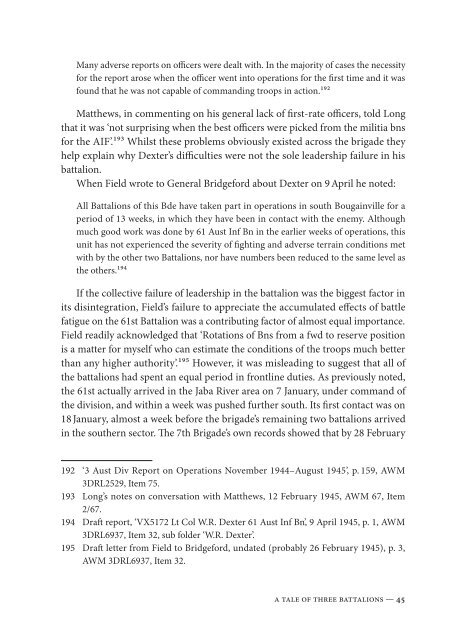View the pdf - Australian Army
View the pdf - Australian Army
View the pdf - Australian Army
You also want an ePaper? Increase the reach of your titles
YUMPU automatically turns print PDFs into web optimized ePapers that Google loves.
Many adverse reports on officers were dealt with. In <strong>the</strong> majority of cases <strong>the</strong> necessityfor <strong>the</strong> report arose when <strong>the</strong> officer went into operations for <strong>the</strong> first time and it wasfound that he was not capable of commanding troops in action.192Mat<strong>the</strong>ws, in commenting on his general lack of first-rate officers, told Longthat it was ‘not surprising when <strong>the</strong> best officers were picked from <strong>the</strong> militia bnsfor <strong>the</strong> AIF’.193 Whilst <strong>the</strong>se problems obviously existed across <strong>the</strong> brigade <strong>the</strong>yhelp explain why Dexter’s difficulties were not <strong>the</strong> sole leadership failure in hisbattalion.When Field wrote to General Bridgeford about Dexter on 9 April he noted:All Battalions of this Bde have taken part in operations in south Bougainville for aperiod of 13 weeks, in which <strong>the</strong>y have been in contact with <strong>the</strong> enemy. Althoughmuch good work was done by 61 Aust Inf Bn in <strong>the</strong> earlier weeks of operations, thisunit has not experienced <strong>the</strong> severity of fighting and adverse terrain conditions metwith by <strong>the</strong> o<strong>the</strong>r two Battalions, nor have numbers been reduced to <strong>the</strong> same level as<strong>the</strong> o<strong>the</strong>rs.194If <strong>the</strong> collective failure of leadership in <strong>the</strong> battalion was <strong>the</strong> biggest factor inits disintegration, Field’s failure to appreciate <strong>the</strong> accumulated effects of battlefatigue on <strong>the</strong> 61st Battalion was a contributing factor of almost equal importance.Field readily acknowledged that ‘Rotations of Bns from a fwd to reserve positionis a matter for myself who can estimate <strong>the</strong> conditions of <strong>the</strong> troops much betterthan any higher authority’.195 However, it was misleading to suggest that all of<strong>the</strong> battalions had spent an equal period in frontline duties. As previously noted,<strong>the</strong> 61st actually arrived in <strong>the</strong> Jaba River area on 7 January, under command of<strong>the</strong> division, and within a week was pushed fur<strong>the</strong>r south. Its first contact was on18 January, almost a week before <strong>the</strong> brigade’s remaining two battalions arrivedin <strong>the</strong> sou<strong>the</strong>rn sector. The 7th Brigade’s own records showed that by 28 February192 ‘3 Aust Div Report on Operations November 1944–August 1945’, p. 159, AWM3DRL2529, Item 75.193 Long’s notes on conversation with Mat<strong>the</strong>ws, 12 February 1945, AWM 67, Item2/67.194 Draft report, ‘VX5172 Lt Col W.R. Dexter 61 Aust Inf Bn’, 9 April 1945, p. 1, AWM3DRL6937, Item 32, sub folder ‘W.R. Dexter’.195 Draft letter from Field to Bridgeford, undated (probably 26 February 1945), p. 3,AWM 3DRL6937, Item 32.A tale of three battalions — 45
















